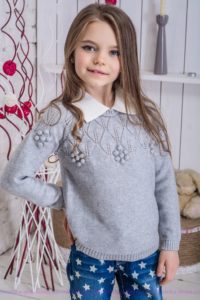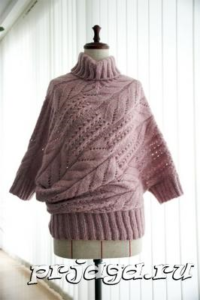 Today's young generation is very picky about their appearance. With an abundance of goods in stores, it is difficult to surprise them with anything. But something related to love can delight the heart of your little princess.
Today's young generation is very picky about their appearance. With an abundance of goods in stores, it is difficult to surprise them with anything. But something related to love can delight the heart of your little princess.
Children's hand-knitted sweaters will perfectly complement the wardrobe of the most picky fashionista. The choice of stylish models is so diverse that you can delight girls with wonderful new clothes all year round.
A beautiful sweater will also serve as proof of your concern for her fragile health. This is especially true in winter weather or autumn dampness. Several recommendations will help you in this difficult work.
What you need for work
If you have enough desire, you can get a stylish thing on the first try. Moreover, there are a lot of educational materials and detailed master classes on the Internet. Just be patient and persevering. It is these two qualities that will allow you to get a warm and beautiful new thing from a ball of thread.
Selecting a model and pattern

Before you go to the store to buy material, you should choose a model. For a beginning needlewoman, it is better to stick to a simple option and a simple pattern.
The most suitable product is one that is made from the bottom up and does not have complex details: pockets, collar or belt.
Of the patterns, the simplest is facial surface. On the front side everything is knitted l. p., and from the inside - i. P.
And also quite easy to implement garter stitch. In this case, all loops are knitted as knit stitches.
Knitting needles, yarn

Having decided on the model, you can go to the store for materials.
Yarn
When purchasing yarn, there are several things to consider.
- For the cold season, choose warm yarn: wool, mohair, alpaca or angora.
- For a summer evening give preference linen, cotton, silk or viscose.
- If you want to get something that you can wear in the off-season use upscale acrylic.
Reference! If you want a beautiful, bright garment, use colorful sectional yarn.
Spokes
- When choosing knitting needles, look at size. Usually the yarn label contains information about what number to knit a given thread.
- Thickness The knitting needles can be determined by folding the thread of the future garment in half: they must match.
- Not the last criterion will be material purchased tool: wood, plastic or metal. A wooden instrument is convenient, but quite fragile and subject to deformation.
Important! If you choose metal knitting needles, wipe them thoroughly with a soft cloth before work. This will remove any residue that could stain the yarn.
How to knit a sweater for a girl with knitting needles
After you have chosen a model and bought yarn, you should take measurements and create a pattern for the future product.To do this, measure the following parameters:
- waist, chest, neck circumferences;
- sweater length (measured along the back from the base of the neck to the estimated edge);
- the length of the sleeve.
Then a pattern is drawn using these dimensions and the sample is knitted. Based on them, calculations of future work are made.
Important! When constructing your pattern, be sure to add a couple of inches on all sides for the seams and loose fit.
A simple model for a beginning craftswoman

If this is your first time picking up knitting needles, then this model will suit you best.
To have enough for a children's sweater, you need to purchase section-dyed yarn with characteristics of 400g\100m and 2.5 knitting needles. It is important to match the pattern: 10x10 cm = 19 loops for 30 rubles; for a sweater for a nine-year-old girl you will need approximately 200 g (3 skeins of 100 g or 4 skeins of 50 g).
Patterns
The model is made in two patterns.
- Knit stitch: in 2, 4 and other even numbers - knit, in 1, 3, 5 and further in odd numbers - purl.
- "Rope". In each row, the first and last stitches are edge stitches. Then we make a pattern of two loops. The first is knitted purlwise, the second is removed (also like purlwise), while holding the thread in front of the product. We knit the second row according to the pattern, with each loop again removed as a purl, only this time the thread is at work. Alternate the first and second row.
Back
- The part is made of 82 loops. Now the “rope” is not done over the entire product, but is diluted with satin stitch (2 rows by 2 rows). Thus we knit in height 38 cm.
- We continue working with stockinette stitch.
- To get an armhole, we make a decrease. On each side we decrease 4 times by 1 p. We decrease the loops in the second rows.
- In this way we knit 10 cm, after which we close the central 18 loops.Next, we knit the back separately: the right and left sides of the neck.
- To round the neckline, decrease the stitches on the wrong side of the back. Rounding pattern: once at a time - first 1, then 2 loops, then three more times 1 p.
- We do 2 more p. and finish knitting the back by closing all the loops.
Before
The front part is knitted similarly. But to make the neckline deeper, we begin to make it 6 cm after we have marked the armhole. The first closure in the center is made from 8 sts.
Then in each row, bind off on each side 1 time for 1 p., 1 time for 2 p., 3 times for 1 p.
Knit 1 p. without decreases, then decrease 1 p., another row without decreases, then again 1 p.
Knit two rows without decreasing and bind off all stitches.
Sleeves
Cast on 82 stitches and knit as follows. 2 r. “rope”, 2 r. stockinette stitch, 2 - “rope”, (6 cm with stockinette stitch and 2 rows of “rope”) repeat () until the height is 32 cm.
Next knit in stockinette stitch. To bevel the sleeves simultaneously with the second repeat of the pattern, decrease 1 p.
Remove 6 stitches evenly in five rows.
Then perform a sleeve roll: in every second row you need to remove 4x1p, in every fourth row 2x1p, in every second 3x1p. And on the next row, decrease two stitches on one side and one loop on the other.
Repeat the next row in the same way. Next, remove 3 stitches on one side and 3 stitches on the other. Cast off the remaining stitches. Do the same for the second sleeve.
With openwork pattern

An openwork jumper is best suited to protect your daughter from the chill on a summer evening. This stylish thing is best made from a plain material. Of course, you can use a multi-colored version, but there is a risk that the beauty and elegance of the pattern will be lost in the play of colors.
To make this model, cotton yarn 250–300 g\100 m is best suited. You will also need knitting needles 3.5 and 4.
The bottom of the product is made according to scheme 2, and the top according to scheme 1.
The sleeves are made with a pattern according to scheme 2.

Read the job description.
- Start working by creating a pattern: you can take the model shown in the photo as a sample, making the necessary adjustments for your size.
- Knit the details of the back, front and sleeves.
- Carry out wet heat treatment (WHT).
- Sew shoulder and side seams.
- Sew in sleeves.
- Crochet the neckline, the bottom of the product and the edges of the sleeves as follows: five single crochets, a picot of four chain stitches, repeat.
With an image

Various figures of animals and birds are the best decoration for children's clothing. The key to success in this case is provided by schemes that must be strictly followed. Typically, such patterns are made using stockinette stitch using yarn of various colors. Sometimes the pattern can be combined with arans, rice or other relief stitches. But this technique requires special skill. For your first experience, it is better to use traditional options.
This model not only looks beautiful, but also, thanks to the muted color scheme, will not get very dirty. To implement it, make the calculations as for regular knitting, and place the owl drawing in the center, the diagram of which is shown in the photo.

You will need five different shades of yarn, knitting needles and a knitting needle.
Reference! For greater attractiveness, it is advisable to duplicate the outline of the pattern with a decorative stitch.
Model for teenage girl

For teenage clothing, a discreet look is more appropriate. But at the same time, the basis is the desire to emphasize the emerging femininity and freshness of youth.Sometimes teenagers prefer unusual, even somewhat challenging clothes.
For girls, asymmetrical models, various arans, complemented by an adjacent silhouette, or bright, spacious sweaters are perfect.
This model is knitted from mixed yarn (merino\alpaca) and knitting needles 4.5; 5.0; 5.5; 6.5. The pattern shows the knitting direction. The back, front and sleeve cuffs are knitted on 4.5 needles. The neckline piece is cast on 4.5 knitting needles and evenly moves first to 5.0, then to 5.5 and 6.5.

The back and front pieces are knitted according to the pattern. The neckline, cuffs and bottom of the product are knitted with a 2x2 elastic band.

Tips for knitting a sweater for girls
In order for the knitting process to be enjoyable and proceed without problems, you need to take a responsible approach to organizing your workplace and have more patience. Here are some useful tips to help you avoid trouble.
- Be sure to wind the yarn into a ball before you start knitting. This will protect you from unpleasant surprises that may be hidden inside the skein: torn thread, manufacturing defects.
- It is advisable to place the balls in a plastic container; a regular small bucket is quite suitable for this. Firstly, this way the thread will not catch debris from the floor (in a house where women live and have pets, there may be hair and fur on the floor. And secondly, it will help the yarn not to get tangled with each other if you use several skeins.
- Apply the piece to the pattern more often.
- Do not neglect wet-heat treatment.


 0
0





